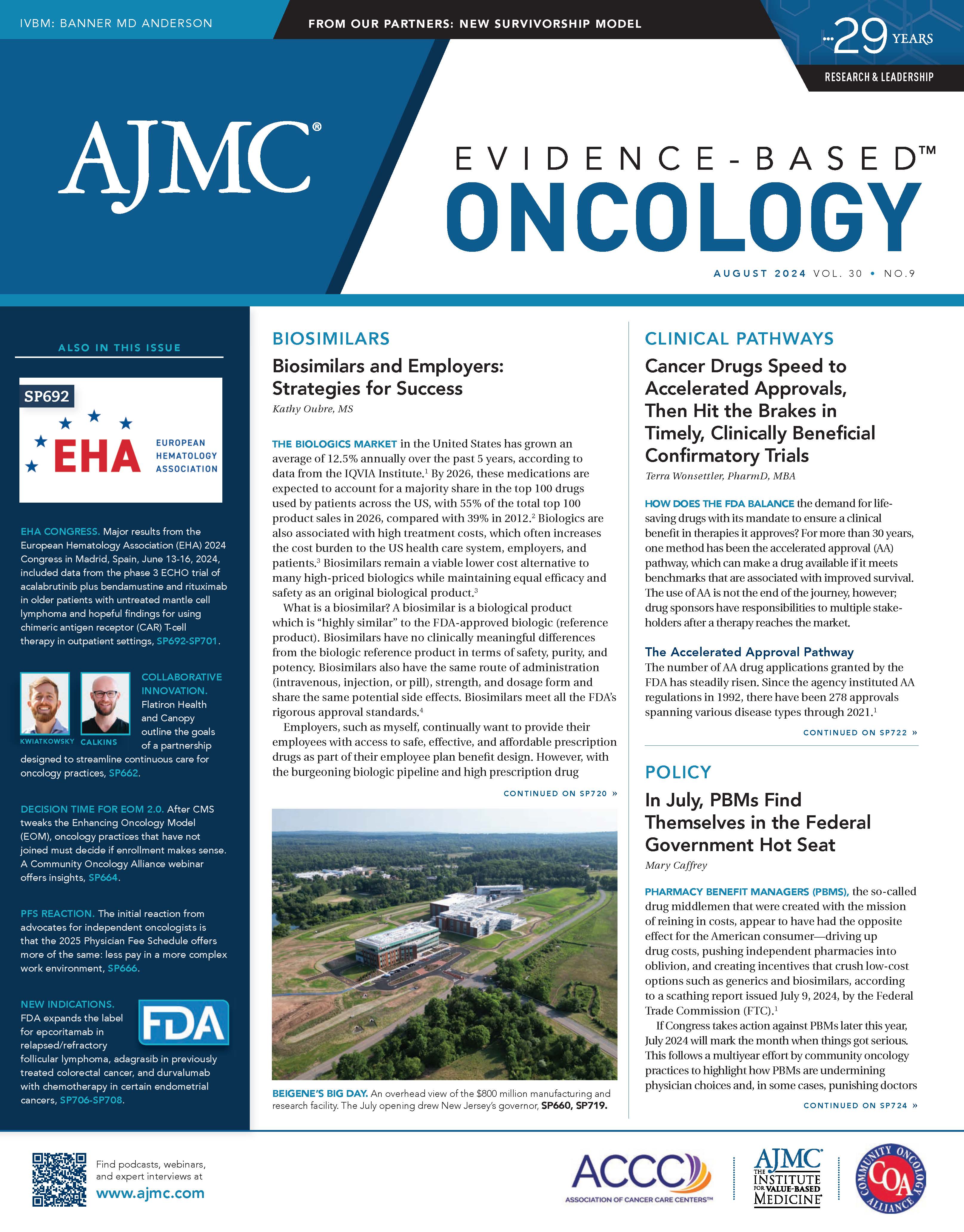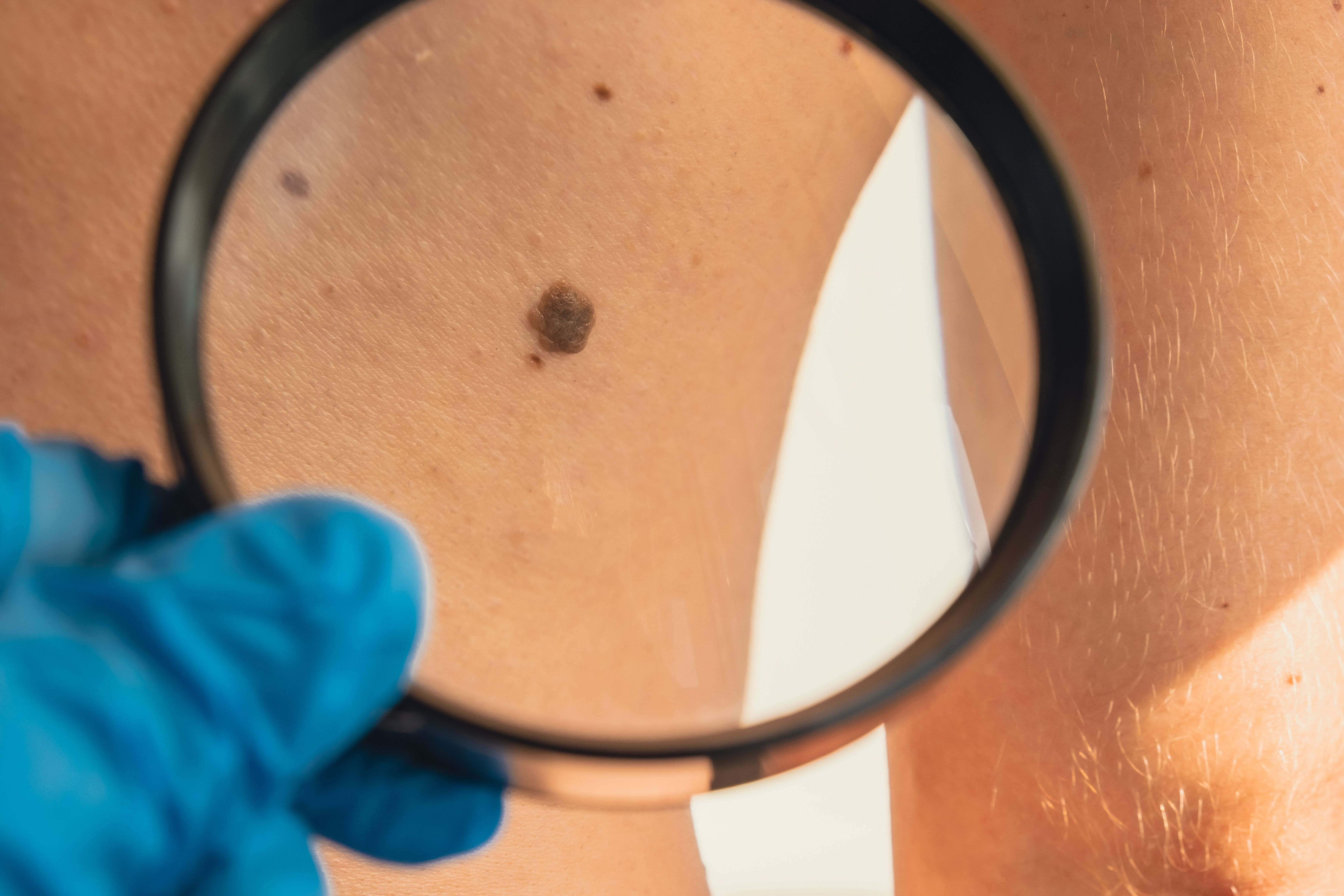Publication
Article
Evidence-Based Oncology
Biosimilars and Employers: Strategies for Success
Author(s):
This article first appeared on The Center for Biosimilars®.
The biologics market in the United States has grown an average of 12.5% annually over the past 5 years, according to data from the IQVIA Institute.1 By 2026, these medications are expected to account for a majority share in the top 100 drugs used by patients across the US, with 55% of the total top 100
Kathy Oubre, MS | Image: LinkedIn

product sales in 2026, compared with 39% in 2012.2 Biologics are also associated with high treatment costs, which often increases the cost burden to the US health care system, employers, and patients.3 Biosimilars remain a viable lower cost alternative to many high-priced biologics while maintaining equal efficacy and safety as an original biological product.3
What is a biosimilar? A biosimilar is a biological product which is “highly similar” to the FDA-approved biologic (reference product). Biosimilars have no clinically meaningful differences from the biologic reference product in terms of safety, purity, and potency. Biosimilars also have the same route of administration (intravenous, injection, or pill), strength, and dosage form and share the same potential side effects. Biosimilars meet all the FDA’s rigorous approval standards.4
Employers, such as myself, continually want to provide their employees with access to safe, effective, and affordable prescription drugs as part of their employee plan benefit design. However, with the burgeoning biologic pipeline and high prescription drug costs, especially specialty drugs, the goal of controlling cost while maintaining high-quality prescription drug benefits has become a constant challenge. The current landscape presents an opportunity for employers to revisit the inclusion of biosimilars in their formularies and to develop strategies that will allow their increased use and/or help manage ongoing utilization.
Employers can play a significant role in promoting biosimilars as an alternative to more expensive biologic drugs, where medically appropriate. Here are 4 areas I’ve focused on over the last few years at my practice:
- Increase understanding of biosimilars by health plan participants and health care providers through education and incentives,
- Adopt clinical management programs,
- Design the payment feature of prescription drug benefits to account for biosimilars, and
- Address biosimilar drugs when negotiating pharmacy benefit manager (PBM) contracts.
Implementing these strategies may help increase biosimilar awareness and use and help employers maximize their cost savings on specialty drugs.
Increase Understanding of Biosimilars by Health Plan Participants and Health care Providers. While many oncologists are familiar with and heavily use biosimilars, there remains a large group of health care providers and their patients who are new to the issue which raises an opportunity for both health care provider (HCP) and patient awareness and education. To help support this process, the FDA has produced a variety of educational materials for patients and providers.5 These materials include graphics, drop-in content for customization at a practice level, as well as social media content. These materials have served as our “go-to” when we originally launched biosimilar education for the HCPs and employees at our practice. And it continues to serve as our primary resource for re-education or education for new staff.
Employers may also want to use the FDA resource when thinking about plan participant education.6 Other areas of consideration include highlighting biosimilar use and potential cost savings as well as real-time benefit lookup tools and cost calculators. Given the surge of newly launched biosimilars and a look at the pipeline, it may also be appropriate to revisit patient biosimilar education and how biosimilars fit into their plan benefit design. Employers should also align with HCPs to promote awareness and consideration of biosimilars as a preferred treatment option.
Adopt Clinical Management Programs. Prior authorization is one of the most common utilization management (UM) strategies used by employers and payers. In theory, this UM technique helps ensure appropriate use of selected drugs. Biosimilars should be included in this PA process as a high quality, less costly alternative to more expensive biologic drugs. Site of care management is also a viable clinical management program to reduce overall health care costs. Employers should evaluate the cost differences among hospitals and community-based practices who dispense the same drug. Additionally, employers should work with their payers and benefit advisors to encourage plan participants to obtain care at the most cost-effective and highest-quality facilities.
In 2019, there was a case study of a large self-funded health plan that conducted a drug review of high-cost injectable claims for the specialty drugs Herceptin and Neulasta, to help ensure patients start and continue therapy at a clinically appropriate and cost-effective healthcare provider. The study showed that the outpatient hospital setting had higher charges than community-based physicians for the same treatment. This cost differential could lead to potential savings to employers through site-of-care analysis, plan design, and contracting strategies which avoid high-cost settings. Another example of potential savings is seen within my own practice, especially at the beginning of the year when deductibles reset. I like to explain it like buying a car. The patients will need to satisfy their annual deductible before their plan benefit kicks in. By utilizing biosimilars as a high quality, less costly alternative, it allows patients to pay into their deductible over a longer time period because each individual treatment is less expensive. Subsequently, it helps alleviate some of the financial burden and stress when also considering daily living expenses such as food, mortgages, and transportation.
Design the Payment Features of Prescription Drug Benefits. Employers interested in expanding the use of biosimilars by their plan participants should confirm that biosimilars are included in the payment provisions of their prescription drug benefit. This can be accomplished through plan design and formulary strategy. Plan design can be used to help mitigate growing prescription drug costs with the goal of balancing quality and cost savings. Tiering places equally effective drugs in different tiers to incentivize the use of the least costly tiers. Typically, it rewards a patient with a lower co-pay for using a lower-cost generic or preferred brand-name drug. In a traditional 3-tier design, generics typically fall in tier 1. However, employers are now implementing 4, 6, or 8-tier benefit designs. These tiering strategies are designed to further drive consumerism around the price of a medication. As the number of biosimilars in the market grows, we may see an increased use of multitier plan designs, especially for specialty drugs.
Formulary strategies typically are a blend of drugs with a preferred or non-preferred status or excluded drugs. An exclusion strategy is where a particular drug is left off the drug formulary. Preferred and nonpreferred status is a formulary strategy which may play a role during price negotiations with the PBM and pharmaceutical manufacturers because it promotes more competitive pricing within a drug class. These strategies vary by PBM and play a large role in the specific formulary and overall cost strategy.
Address Biosimilar Drugs when Negotiating PBM Contracts. Even though the biosimilar market has become more challenging than 2 to 3 years ago, we still see biosimilars as being 15% to 20% less expensive than their biologic counterparts.7 And while these savings may not be as high as those of generic drugs, they can still provide meaningful cost reductions for the expensive biologics. One way to address biosimilars during PBM negotiations is through inflation-protection caps, which are intended to shield plans from the full impact of year-over-year price increases. This is a good opportunity for employers to understand how their plan’s inflation cap is calculated by the PBM and confirm the PBM delivers these protections to all specialty drugs, including biosimilars. Another opportunity is to address manufacturer rebates when discussing biosimilar inclusion with the PBM. PBMs negotiate rebates from drug manufacturers for formulary placement. Higher rebates are paid by the manufacturer to have their drug receive a preferred formulary position. Plan sponsors should use this as an opportunity to ensure that biosimilars are included in rebate payment calculations. All that being said, it’s also important for employers to review their PBM contract provisions with their benefit advisors and legal counsel, including inflation-protection caps and manufacturer rebates.
Putting the Biosimilar Pieces Together. Even though the biosimilar marketplace may be challenging, it is an opportunity for increasing patient access while reducing costs. This can be accomplished by working with partners, developing and implementing a biosimilar strategy, and creating and increasing patient and HCP awareness. Employers should work with their PBMs, health plan carriers, benefit consultants, and legal counsel to understand the ongoing biosimilar market and pipeline of new drugs. It is also important for employers to identify which PBMs are promoting greater use of biosimilars and include biosimilar provisions and competitive payment features in their PBM contracts. Employers may also include biosimilars in their pharmacy benefit strategy as a cost-savings strategy. Additionally, there are several clinical management strategies employers can take to improve the quality of care offered to plan participants while also lowering costs. And there are real opportunities to increase biosimilar awareness through education campaigns aimed at plan participants and health care providers. It may also be helpful to consider how PBMs and plan carriers handle current biosimilars and their strategy for newly launched biosimilars and formulary management.
References
1. Biosimilars in the United States 2023-2027. IQVIA Institute. January 31, 2023. Accessed January 2024. https://www.iqvia.com/insights/the-iqvia-institute/reports-and-publications/reports/biosimilars-in-the-united-states-2023-2027
2. EvaluatePharma World Review 2020, Outlook to 2026, 13th edition. EvaluatePharma. July 2020. Accessed August 7, 2024. https://fondazionecerm.it/wp-content/uploads/2020/07/EvaluatePharma-World-Preview-2020_0.pdf9
3. Giuliani J, Bonetti A. The economic impact of biosimilars in oncology and hematology: the case of trastuzumab and rituximab. Anticancer Res. 2019;39(7):3971-3973. doi:10.21873/anticanres.13552
4. U.S. Food and Drug Administration. What are “biologics” questions and answers. Accessed March 2019. https://www.fda.gov/about-fda/center-biologics-evaluation-and-research-cber/what-are-biologics-questions-and-answers
5. Food and Drug Administration. “Health Care Provider
Materials.” Accessed January 2020. https://www.fda.gov/drugs/biosimilars/curriculum-materials-health-care-degree-programs-biosimilars.
6. Food and Drug Administration. “Prescribing Biosimilar and Interchangeable Products.” Accessed January 2020. https://www.fda.gov/media/112818/download
7. Feng K, Russo M, Maini L, Kesselheim AS, Rome BN. Patient out-of-pocket costs for biologic drugs after biosimilar competition. JAMA Health Forum 2024;5(3):e235429. doi: 10.1001/jamahealthforum.2023.5429






